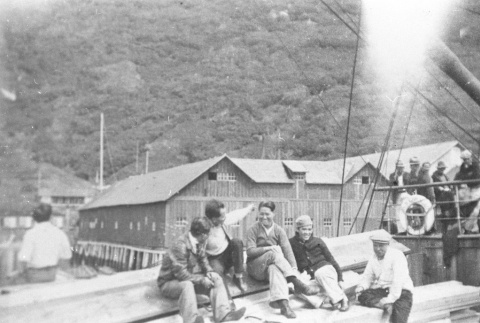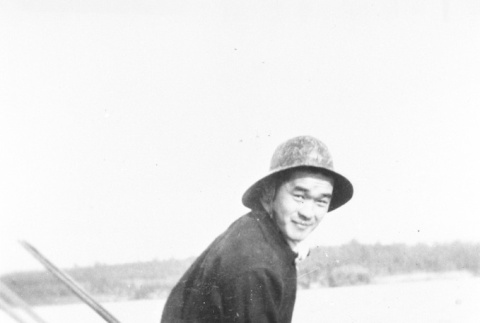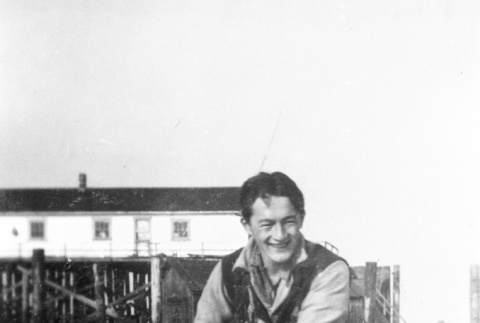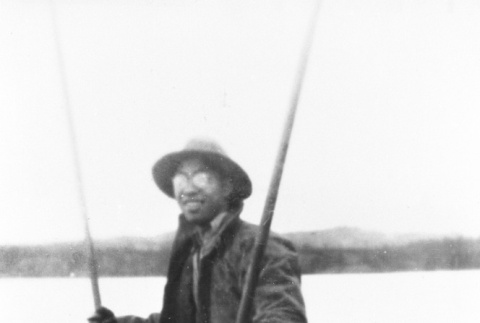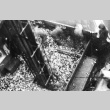Fishing and canneries
Japanese Americans found work at salmon canneries along the Columbia River in Oregon and Washington, and their labor was welcomed in Alaskan towns such as Ketchikan and Petersburg as early as the 1890s. They traveled by ship to the cannery towns, where they slowly developed small communities whose population swelled with the yearly arrival of workers. Issei (Japanese immigrant) entrepreneurs started the oyster industry from scratch in Puget Sound. Japanese American oyster farms became thriving businesses before World War II.
Industry and employment
(481)
Fishing and canneries
(256)
Related articles from the
Densho Encyclopedia :
Takahashi v. Fish and Game Commission
256 items
256 items

img
Cannery workers (ddr-densho-15-41)
These workers are at Shear Water Bay near Kodiak Island. They appear to be playing cards. Left to right: unidentified, Tom Matsudaira (cannery foreman), "Cannon" Watanabe, (first name unknown) Yamasaki, and Paul Sakai.

img
Two men holding their halibut catch (ddr-densho-15-25)
George Munato (left) and Takeo Dozen hold their catch of halibut from the Shear Water Bay area of Kodiak Island. The item on top of the halibut is a skate.

img
Men leaving for Alaska (ddr-densho-15-38)
These Japanese Americans are en route to Alaska to work in the canneries. Several can be identified: "Turk" Fujiya and Jim Yoshida stand fifth and sixth from the left; Ben Uyeno and George Yano stand third and second from the right. Ben Uyeno later became a well-known doctor in Seattle's Japanese American community. He was interviewed …

img
Unloading oysters from a bateau (ddr-densho-15-114)
Workers unloading oysters at the Willa Point Oyster Company, where the oysters were canned for shipping.

img
Seed oyster boxes (ddr-densho-15-112)
These boxes once contained seed oysters from Japan. The oysters were strewn in the beds where oyster spawn or "spats" would attach themselves to the shells. The oysters were harvested the following season.

img
Cannery workers (ddr-densho-15-20)
These workers are sitting on plywood in front of the cannery.
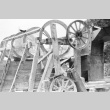
img
Oyster processing machine (?) (ddr-densho-15-31)
This photo was taken at the Yamashita oyster farm. The machine might have been used to process oyster shells.

img
Oyster farmer (ddr-densho-15-100)
Norio Mitsuoka is farming oysters. Two long tongs allowed farmers to harvest oysters before the tide was completely out. Each tong had a "rake" at the end, and the farmers would scoop the oysters together between the rakes and haul them up. When full, the load weighed approximately 20 to 30 pounds. Oyster harvesters were paid …
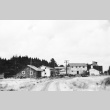
img
New Washington Oyster Company (ddr-densho-15-92)
Oyster companies, such as New Washington, hired many Japanese American workers during the harvesting season.

img
Station-house dock (ddr-densho-15-94)
Oyster-farm workers often lived in station houses built on pilings in the bay. Since the only way to access the house was by boat, the houses had floating docks, such as the one shown here.

img
Interior of cannery (ddr-densho-15-43)
Interior of the cannery before it was opened for the season. Note that several of the machines are disassembled.
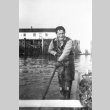
img
Oyster farmer (ddr-densho-15-101)
"Turk" Fugiya pushes a bateau, a small barge, with a pole. The harvested oysters were loaded on bateaux and moved by towing or by digging and pushing off on long poles.

img
Departure from the canneries (ddr-densho-15-42)
These workers are in Shear Water Bay near Kodiak Island. They are about to leave the canneries.

img
Canned salmon (ddr-densho-15-89)
The cans of salmon have been set out to cool after being cooked and cleaned.

img
Oyster-farm station house (ddr-densho-15-104)
The station house is where oyster farmers lived during the harvesting season. The house was erected on pilings. In the foreground is a bateau, or small barge, that was used to haul oysters.

img
Willa Point Oyster Company (ddr-densho-15-113)
The Willa Point Oyster Company canned local oysters for shipping.

img
Oyster bateau and scow (ddr-densho-15-116)
The scow (upper right) and oyster bateau (lower right) harvested oysters together. The scow was equipped with a winch-operated dredge, which was lowered and dragged across the oyster beds at high tide. Oysters were then loaded onto the bateau and delivered to the processing plant. Both scows and bateaux had to be towed.

img
Oyster processing machine (?) (ddr-densho-15-32)
This machine from the Yamashita oyster farm might have been used to process oyster shells.

img
Oyster farmer (ddr-densho-15-99)
Hisato "Monks" Yano harvesting oysters with tongs. Tongs were used when the tide was not completely out. Oysters were collected between two rakes, one at the end of each pole. The harvester pushed the poles together, closing the rakes, then pulled up the oysters. One load weighed approximately 20 to 30 pounds.

img
Oyster farmer (ddr-densho-15-96)
Mr. Okazaki gathering oysters in bushel baskets. When full, the baskets were emptied onto the bateau in the background. If the flats were muddy, the baskets were pulled to the bateau on wooden slats. The gloves worn by Okazaki were made from canvas covered with rubber. Because of the sharp oyster shells, a pair of gloves …

img
Semmy (ddr-densho-287-171)
Photograph of Semmy holding a piece of lumber next to a river. Written below the image on the album page is "Semmy" in white ink.






